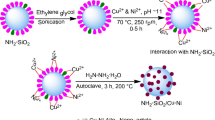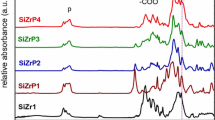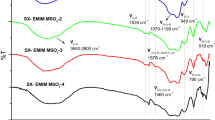Abstract
The sol-gel process is a useful method for preparing two series of organically and co-ordinately modified xerogels of the types [CuN n ]·N 5−n ·5xSiO4/2 (n < 4) and [Cu(N−N)n]·(N−N)2−n ·2x SiO4/2(n ≤ 2), where N = NH2(CH2)3 SiO3/2, N−N = NH2(CH2)2NH·(CH2)3SiO3/2 and x = [SiO4/2]/[N] or [SiO4/2]/[N−N]. The amino groups in the materials are coordinately active and participate partly in the coordination sphere of Cu(II) ions. The composition of the coordination sphere can be varied with the SiO4/2 content and also as a result of the thermal decomposition of the organic residues at higher temperatures.
Because the xerogel materials are considered to be catalyst precursors, this study is focused on their coordination and thermal properties. The prepared xerogels, such as silica, aminated silicates with N and N−N, as well as those entities complexed with Cu(II), were characterised by FT-IR spectroscopy. During gelation and thermal decomposition the materials were analysed by electron paramagnetic resonance (EPR) spectroscopy. The xerogels were additionally studied by UV-Vis absorption spectroscopy. The gaseous products of the thermal decomposition of these materials in an Ar atmosphere were investigated by the use of FT-IR spectroscopy coupled with TG and DTG thermal analysis. These data were complemented by temperature-programmed decomposition (TPDec) in a 2% O2 + 98% Ar stream coupled with quadrupole mass spectroscopy.
Similar content being viewed by others
References
F.R. Hartley, Supported Metal Complexes (Reidel, Dordrecht, 1985), p. 68.
C.J. Brinker and G.W. Scherer, Sol-Gel Science. The Physics and Chemistry of Sol-Gel Processing, (Academic Press, Boston, 1990).
H. Schmidt and B. Seiferling, in Better Ceramics Through Chemistry II, edited by C.J. Brinker, D.E. Clark, and D.R. Ulrich (Mater. Res. Soc., Pittsburgh, PA, 1986), p. 739.
A.M. Kłonkowski and C.W. Schläpfer, J. Non-Cryst. Solids 129, 101 (1991).
A.M. Kłonkowski and C.W. Schläpfer, J. Non-Cryst. Solids 149, 189 (1992).
A.M. Kłonkowski, K. Koehler, and C.W. Schlaepfer, J. Mater Chem. 3, 105 (1993).
A.M. Kłonkowski, T. Widernik, and B. Grobelna, Molec. Enging 5, 381 (1995).
A.M. Kłonkowski, K. Koehler, T. Widernik, and B. Grobelna, J. Mater. Chem. 6, 579 (1996).
C. Furlani, Coord. Chem. Rev. 3, 141 (1968).
I.M. Campbell, Catalysis at Surfaces (Chapman and Hall, London, 1988), p. 56.
D. Kivelson and R. Neiman, J. Chem. Phys. 35, 149 (1961).
A.H. Maki and B.R. McGarvey, J. Chem. Phys. 29, 31 (1958).
F.K. Kneubühl, J. Chem. Phys. 33, 1074 (1960).
G. Orcel, J. Phalippou, and L.L. Hench, J. Non-Cryst. Solids 88, 114 (1986).
K. Kobayashi, Glass Technol. 34, 120 (1993).
I. Shimizu, H. Okabayashi, K. Taga, E. Nishio, and C. O'Connor, J. Vibr. Spectrosc. 14, 113 (1997).
K.C. Vracken, P. Van der Voort, J. Gillis-D'Hamers, and E.F. Vansant, J. Chem. Soc., Faraday Trans. 88, 3197 (1992).
A. Piers and C.H. Rochester, J. Chem. Soc., Faraday Trans. 91, 359 (1995).
M. Schraml-Marth, K.L. Walther, A. Wokau, B.E. Handy, and A. Baiker, J. Non-Cryst. Solids 141, 93 (1992).
E.I. Kamitsos, A.P. Patsis, and G. Kordas,Phys. Rev. B 48, 12499 (1993).
M. Handke and W. Mozgawa, Vibr. Spectrosc. 5, 75 (1993).
D.L. Wood and E.M. Rabinovich, Appl. Spectrosc. 43, 263 (1989).
H. Yashino, K. Kamiya, and H. Nasu, J. Non-Cryst. Solids 126, 68 (1990).
D. Niznansky and J.L. Rehspringer, J. Non-Cryst. Solids 180, 191 (1995).
J.M. Procter, B.J. Hathaway, and P. Nichols, J. Chem. Soc. A 1678 (1966).
B.J. Hathaway and D.E. Billing, Coord. Chem. Rev. 5, 143 (1970).
J. Wong and C.A. Angell, Glass Structure by Spectroscopy (Dekker, New York, 1976), ch. 6 and 9.
D.C. Munro, Chem. Br. 13, 100 (1977).
G. Schwarzenbach, Helv. Chim. Acta 35, 2344 (1952).
B.J. Hathaway, in Comprehensive Coordination Chemistry, edited by G. Wilkinson (Pergamon Press, Oxford 1987) vol. 5, pp. 667 ff and 730.
A.A.G. Tomlinson and B.J. Hathaway, J. Chem. Soc. A 1905 (1968).
N.N. Greenwood and A. Earnshaw, Chemistry of the Elements (Pergamon Press, Oxford, 1985), p. 1096.
D.G. Kurth and T. Bein, Angew. Chem. Int. Ed. Engl. 31, 336 (1992).
A.M. Kłonkowski, B. Grobelna, A. Jankowska-Frydel, T. Widernik, and W. Mozgawa, Langmuir 15, 5814 (1999).
Author information
Authors and Affiliations
Rights and permissions
About this article
Cite this article
Kłonkowski, A.M., Widernik, T., Grobelna, B. et al. Amino-Modified Silicate Xerogels Complexed with Cu(II) as Catalyst Precursors. Coordination State and Thermal Decomposition. Journal of Sol-Gel Science and Technology 20, 161–180 (2001). https://doi.org/10.1023/A:1008703623418
Issue Date:
DOI: https://doi.org/10.1023/A:1008703623418




